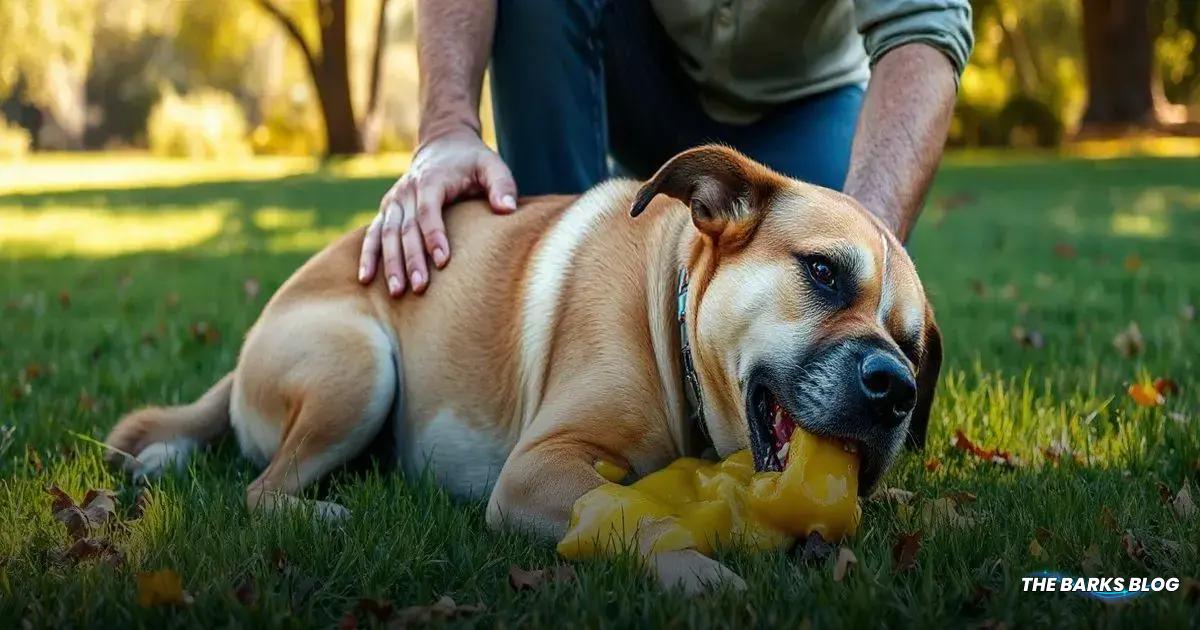Yellow dog vomit can indicate various health issues in dogs, such as bilious vomiting syndrome, gastrointestinal blockages, pancreatitis, infections, food intolerances, toxin ingestion, liver disease, and ulcers. If your dog frequently vomits, shows lethargy, has diarrhea, or exhibits abdominal pain, it’s essential to consult a veterinarian for early intervention and better health outcomes.
If your dog is throwing up yellow bile and foam, you may understandably be concerned. Although vomiting is a common issue for dogs to face and isn’t always something serious, it’s not something to ignore either.

Understanding Yellow Dog Vomit
Understanding the different types of yellow dog vomit is crucial for identifying potential health issues. The color and consistency of your dog’s vomit can provide important clues about what might be going on inside their body.
Yellow Foam: This type of vomit typically appears as yellow liquid topped with white or yellow foam. The foam is often a result of saliva mixing with the stomach acids, which can occur when a dog vomits on an empty stomach.
Yellow Bile: Yellow bile is mostly liquid and can sometimes be seen alongside foam, mucus, or food particles. This type of vomit indicates that bile is present, which is produced by the liver and stored in the gallbladder.
Yellow Mucus: If your dog is vomiting yellow mucus, it may have a thick, stringy, and slimy quality. This can indicate irritation in the gastrointestinal tract.
Chunky Yellow Vomit: If your dog has eaten recently, you might notice yellow chunks in the vomit. These chunks may be the result of food mixed with bile, and the yellow color can either be from the food itself or the bile.
Recognizing these variations in your dog’s vomit can help you and your veterinarian determine the underlying cause and appropriate treatment.

Common Causes of Yellow Vomiting
There are several reasons why your dog might be vomiting yellow material. Understanding these common causes can help you identify when to seek veterinary assistance.
1. Bilious Vomiting Syndrome: This condition occurs when a dog’s stomach is empty for too long, leading to the vomiting of yellow foam or liquid. It often happens in the early morning or late at night.
2. Gastrointestinal Blockage: If a foreign object or tumor obstructs your dog’s digestive tract, it can cause vomiting. Dogs with this issue often exhibit poor appetite and difficulty keeping food down.
3. Pancreatitis: Inflammation of the pancreas, commonly caused by a high-fat diet, can lead to repeated vomiting, diarrhea, abdominal pain, and lethargy.
4. Bacterial or Viral Infections: Infections like parvovirus can cause yellow vomiting. The severity of symptoms can vary based on the dog’s age and vaccination status.
5. Food Intolerances or Allergies: Some dogs may vomit yellow material due to food intolerances or allergies, especially if their diet changes too rapidly.
6. Toxin Ingestion: Ingesting harmful substances, such as antifreeze or chocolate, can lead to vomiting that may become yellow as bile is expelled.
7. Liver Disease: Vomiting is a common symptom of liver disease, which may also present with jaundice, diarrhea, and lethargy.
8. Ulcers: Stomach or intestinal ulcers can cause pain and lead to vomiting, often accompanied by yellow bile.
Each of these causes requires careful evaluation by a veterinarian to determine the appropriate treatment and care for your dog.

When to Seek Veterinary Help
Knowing when to seek veterinary help for your dog is crucial, especially when it comes to vomiting yellow material. Here are some key indicators that warrant immediate attention:
- Frequent Vomiting: If your dog vomits regularly or multiple times a day, it’s essential to consult your veterinarian.
- Accompanying Diarrhea: Vomiting paired with diarrhea can indicate a more serious issue that requires professional evaluation.
- Lethargy: If your dog appears unusually tired, weak, or unresponsive, this could signal a significant health concern.
- Painful Abdomen: A hunched posture or signs of pain when touching your dog’s abdomen are red flags that should not be ignored.
- Decreased Appetite: If your dog is not eating or is unable to keep food down, it’s time to seek veterinary assistance.
- Jaundice: Yellowing of the eyes, gums, skin, or genitals indicates potential liver issues and requires immediate veterinary care.
If your dog exhibits any of these symptoms, especially in combination, do not hesitate to contact your veterinarian. Prompt action can make a significant difference in your dog’s health and well-being.
Conclusion
Understanding why your dog may be vomiting yellow bile is essential for maintaining their health. While occasional vomiting might not be a cause for alarm, consistent yellow vomiting can indicate underlying health issues that require attention.
By recognizing the symptoms and knowing when to seek veterinary help, you can ensure your furry friend receives the care they need. Always consult your veterinarian if you’re concerned about your dog’s vomiting, as early intervention can lead to better outcomes and a quicker recovery for your beloved pet.
FAQ – Frequently Asked Questions about Yellow Dog Vomit
What does it mean if my dog is vomiting yellow bile?
Vomiting yellow bile can indicate several issues, including an empty stomach, gastrointestinal blockages, or infections. It’s important to monitor your dog’s overall health.
Is it normal for dogs to vomit yellow foam?
While vomiting yellow foam can occur occasionally, it is not considered normal. Frequent occurrences should be evaluated by a veterinarian.
When should I take my dog to the vet for vomiting?
You should seek veterinary help if your dog vomits frequently, has diarrhea, shows signs of lethargy, or exhibits pain in the abdomen.
Can food allergies cause yellow vomiting in dogs?
Yes, food allergies or intolerances can lead to gastrointestinal upset, which may result in yellow vomiting. A dietary change may be necessary.
What are some common causes of yellow dog vomit?
Common causes include bilious vomiting syndrome, gastrointestinal blockages, pancreatitis, infections, food intolerances, toxin ingestion, liver disease, and ulcers.
How can I help my dog if they are vomiting yellow bile?
If your dog vomits yellow bile occasionally, try feeding smaller meals more frequently. If symptoms persist or worsen, consult your veterinarian.




